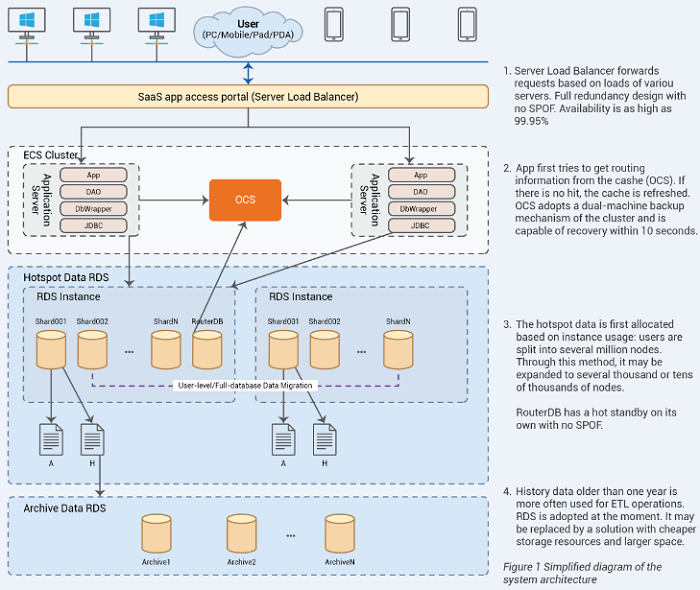SaaS service providers must always consider the large number of users when designing an appropriate business architecture. The large user base and massive user data require both efficiency and stability in the infrastructure construction. However, traditional infrastructure construction programs are costly, laborious, and involve complex implementation.
As a result, a more economical cloud service platform that is more convenient for extension has become the first choice for SaaS providers. However, to build a high-performance SaaS application, cloud service infrastructure alone is not enough. The key to determining product performance is in designing and implementing a system architecture that complies with specific business needs using the cloud service platform.
Hangzhou HUPUN Network Technology Co. Ltd, a start-up SaaS provider, faced these problems in the early stages of development. This post elaborates how Hangzhou HUPUN Network Technology utilized Alibaba Cloud services and adopted relatively cost-effective solutions to solve database usage problems for massive users.
The overall architecture of our SaaS e-commerce ERP is based on the Alibaba Cloud service platform as below.

For us, as a SaaS-oriented enterprise, data is concentrated and data volume is large. Therefore, databases are a key node in our overall structure, and ensuring the stability and performance of databases is our top priority.
Considering the business characteristics, we finally adopted the more common horizontal splitting + vertical splitting policy in the industry, and independently completed the development data access encapsulation layer between DAO and JDBC.
Despite the optimizations in the architecture, often some unsatisfactory performance issues persist in the product development. Under the Alibaba Cloud DBA guidance and assistance, we found that the actual cause lies in the uncontrolled usage of the database in the product design. With the increase in concurrency pressure and data volume, minor performance problems are exposed and amplified.
And sometimes you need to compromise a bit, then please upgrade the configuration in reacting to demands and keep the Pareto principle. For detailed information about this example, pleage go to Database Tuning Best Practices - A Success Story.
SaaS offers flexible scalability and high availability across different geographical locations. For example, SaaS application serves users in Asia and Europe without performance issues or scalability issues if the number of users grows rapidly. Based on this advantage, SaaS can empower your IoT businesses.
Presently, it is important to reconstruct the core idea in intelligent manufacturing, that is, informatization. For most small- and medium-sized enterprises, it is impossible to purchase a set of new and expensive software programs. Therefore, the following solution arises:
First, connectivity aims to digitalize manufacturing. Then, after implementation of factory digitalization, the entire industry cooperates to transform factory manufacturing into services. Finally, a large number of SaaS applications are provided to make manufacturing intelligent.
First, they can break down several vertical industries to form replicable experience and copy it to other industries. On the one hand, education, healthcare, manufacturing, and other industries are all looking for an opportunity to leverage IoT. Meanwhile, the SaaS market has matured. The IoT platform is creating numerous opportunities for SaaS services and industries. For example, H3C's Oasis Platform controls the IoT APs to provide campuses with an in-depth IoT "cloud-network-terminal" service. It is prudent to rely on its advantages and seize the industrial opportunities.
Currently, the IoT platform does not entirely solve the difficulties businesses have to encounter in the IoT development. However, the era of a more intelligent and sophisticated Internet of Everything will become a reality with the opening of the IoT business, continuous integration of various industries, and sophistication of cloud computing, AI, and other technologies.
Application High Availability Service (AHAS) is a SaaS product that focuses on improving the high availability capabilities of applications. It has three main function modules:
• Topology:
• High availability capabilities assessment:
• AppGuard:
Alibaba Group provides Alibaba Cloud Log Service as a solution to log scenarios. As the number of users grows and the business evolves, Alibaba Cloud has applied Log Service to log analysis in Ops scenarios, such as DevOps, Market Ops, and DevSecOps. It is a software as a service (SaaS)-based service. You do not need to worry about capacity or concurrency. It supports auto scaling and is O&M-free.
Alibaba Cloud offers global cloud computing services to power your business, including large-scale computing, storage resources, and Big Data processing capabilities for users around the world.
A highly efficient and agile platform where ecosystem partners can easily build and launch SaaS applications and leverage Alibaba's proven business and technology know-how. The accelerator helps SaaS customers quickly deploy and test their applications on the cloud, shorten the implementation lifecycle, and accelerate time-to-market. It features an intuitive, drag-and-drop interface and launch kit while remaining highly compatible with other application programming interfaces (APIs). With the accelerator, a smart SaaS application can go live in as little as five days.
Anti-Bot Service provides comprehensive bot defense for Web applications, HTML5 websites, mobile apps, and APIs. It can effectively reduce the risks caused by specific vulnerabilities. You can use Anti-Bot Service in the following scenarios: flight seating occupancy, online scalping, user enumeration, and core API exploitation. Anti-Bot Service is a reverse proxy technology based SaaS solution that allows you to specify custom protection policies to identify and control malicious traffic. You can also view the protection status in the console.

2,599 posts | 769 followers
FollowAlibaba Clouder - July 26, 2019
Alibaba Clouder - August 24, 2017
Iain Ferguson - March 10, 2022
Alibaba Clouder - July 11, 2019
Alibaba Cloud Community - June 14, 2024
Alibaba Cloud MVP - March 4, 2020

2,599 posts | 769 followers
FollowMore Posts by Alibaba Clouder